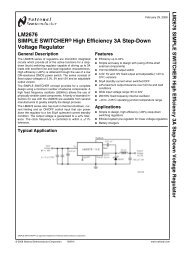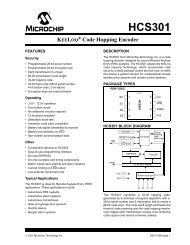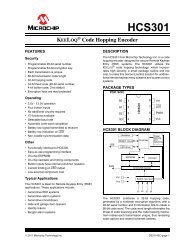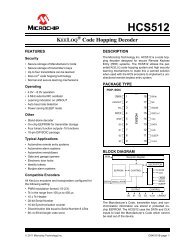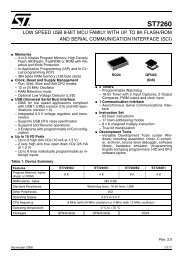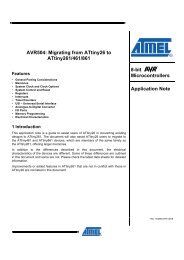dsPIC30F2010 Data Sheet - Microchip
dsPIC30F2010 Data Sheet - Microchip
dsPIC30F2010 Data Sheet - Microchip
You also want an ePaper? Increase the reach of your titles
YUMPU automatically turns print PDFs into web optimized ePapers that Google loves.
<strong>dsPIC30F2010</strong><br />
4.1.2 MCU INSTRUCTIONS<br />
The three-operand MCU instructions are of the form:<br />
Operand 3 = Operand 1 Operand 2<br />
where Operand 1 is always a working register (i.e., the<br />
Addressing mode can only be register direct), which is<br />
referred to as Wb. Operand 2 can be a W register,<br />
fetched from data memory, or 5-bit literal. The result<br />
location can be either a W register or an address<br />
location. The following Addressing modes are<br />
supported by MCU instructions:<br />
• Register Direct<br />
• Register Indirect<br />
• Register Indirect Post-modified<br />
• Register Indirect Pre-modified<br />
• 5-bit or 10-bit Literal<br />
Note: Not all instructions support all the<br />
Addressing modes given above. Individual<br />
instructions may support different<br />
subsets of these Addressing modes.<br />
4.1.3 MOVE AND ACCUMULATOR<br />
INSTRUCTIONS<br />
Move instructions and the DSP Accumulator class of<br />
instructions provide a greater degree of addressing<br />
flexibility than other instructions. In addition to the<br />
Addressing modes supported by most MCU instructions,<br />
Move and Accumulator instructions also support<br />
Register Indirect with Register Offset Addressing<br />
mode, also referred to as Register Indexed mode.<br />
Note:<br />
For the MOV instructions, the Addressing<br />
mode specified in the instruction can differ<br />
for the source and destination EA. However,<br />
the 4-bit Wb (Register Offset) field is<br />
shared between both source and<br />
destination (but typically only used by<br />
one).<br />
In summary, the following Addressing modes are<br />
supported by Move and Accumulator instructions:<br />
• Register Direct<br />
• Register Indirect<br />
• Register Indirect Post-modified<br />
• Register Indirect Pre-modified<br />
• Register Indirect with Register Offset (Indexed)<br />
• Register Indirect with Literal Offset<br />
• 8-bit Literal<br />
• 16-bit Literal<br />
Note: Not all instructions support all the<br />
Addressing modes given above. Individual<br />
instructions may support different<br />
subsets of these Addressing modes.<br />
4.1.4 MAC INSTRUCTIONS<br />
The dual source operand DSP instructions (CLR, ED,<br />
EDAC, MAC, MPY, MPY.N, MOVSAC and MSC), also<br />
referred to as MAC instructions, utilize a simplified set of<br />
Addressing modes to allow the user to effectively<br />
manipulate the data pointers through register indirect<br />
tables.<br />
The two source operand prefetch registers must be a<br />
member of the set {W8, W9, W10, W11}. For data<br />
reads, W8 and W9 will always be directed to the X<br />
RAGU and W10 and W11 will always be directed to the<br />
Y AGU. The effective addresses generated (before and<br />
after modification) must, therefore, be valid addresses<br />
within X data space for W8 and W9 and Y data space<br />
for W10 and W11.<br />
Note:<br />
Register Indirect with Register Offset<br />
Addressing is only available for W9 (in X<br />
space) and W11 (in Y space).<br />
In summary, the following Addressing modes are<br />
supported by the MAC class of instructions:<br />
• Register Indirect<br />
• Register Indirect Post-modified by 2<br />
• Register Indirect Post-modified by 4<br />
• Register Indirect Post-modified by 6<br />
• Register Indirect with Register Offset (Indexed)<br />
4.1.5 OTHER INSTRUCTIONS<br />
Besides the various Addressing modes outlined above,<br />
some instructions use literal constants of various sizes.<br />
For example, BRA (branch) instructions use 16-bit<br />
signed literals to specify the branch destination directly,<br />
whereas the DISI instruction uses a 14-bit unsigned<br />
literal field. In some instructions, such as ADD Acc, the<br />
source of an operand or result is implied by the opcode<br />
itself. Certain operations, such as NOP, do not have any<br />
operands.<br />
DS70118J-page 32<br />
© 2011 <strong>Microchip</strong> Technology Inc.





